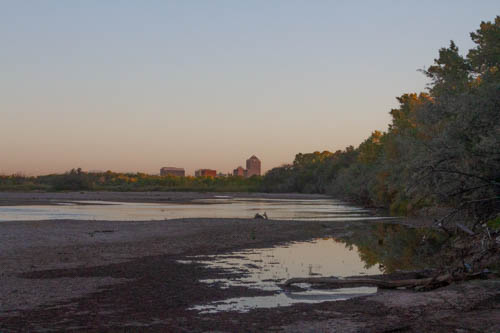I got up early today, threw a camera and a bike in the car, and headed down to the Rio Grande.
There’s a spot south of downtown I discovered last month where, when the river’s low, you can get out on the sand flats and look up to see downtown, rising above the river bed.
I just had a phone camera with me when I found it, so I’ve been meaning to get back. With flows about to jump up as river managers move water currently sitting behind upstream dams, I’m about to lose my chance to get a picture I really want for the book.
It’s a couple of miles down the levee from the Barelas Bridge, at a gap in the bosque along a power line. It can be hard to get to the river sometimes because of the heavily anchored treelines along the banks, but power lines usually have a path.
f/8 and be there
It’s apparently not at all clear that the famous New York street photographer Arthur Fellig actually coined the phrase “f/8 and be there”, but it’s too good not to tell the story that way, so it’s stuck.
Fellig – “Weegee” – would almost supernaturally show up at the scene of chaos (hence “Weegee” after the “Ouija board”).
In Weegee’s day, photographers had to master tricky manual settings on their camera. In my childhood, I remember dad’s light meter, and the fiddling with the camera’s f stops – essentially the size of the shutter opening – and shutter speeds.
Dad was an artist, working at a different pace that a street photographer like Weegee, with his Speed Graphic and flashbulbs. f/8 is a mid-range aperture setting that’s pretty forgiving, and gives you a decent shot under a variety of conditions.
But it’s not so much the “f/8” that matters here. It’s the second part – “and be there”. As I explained when describing one of my favorite book-writing escapades….
One of my journalistic techniques is to try to put myself in a place where something interesting is likely to happen, something real, and then wait.
I’ve been around photography my whole life. My dad, an artist, learned photography from the Army during World War II, and always had cameras. The photography itself wasn’t his art, it was a tool to capture imagery doing aesthetic work on his behalf. My wife, Lissa, also an artist, has always had cameras, always used photographs to make art.
From the beginning of my newspaper career, I worked with photojournalists, offloading the visual insights to a professional. But I always preferred going out with the shooter, not just sending them to take pictures. The photos and the words worked best when they worked closely together.
Toward the end of my career, I started shooting my own pictures, and it’s given me great joy. I’m not great at it – I know having lived and worked with terrific photographers. But I’m cool with my own mediocrity.
It’s the “be there” part. Camera technology today is so forgiving that you don’t need to think much about the “f/8” part, but the “and be there” is a conceptual joy.
I’m writing a book about a city and a river. It’s hard to fit those two things in a single frame. When I walked out in the river bed last month, looked upstream, and saw Albuquerque’s icononic pointy buildings poking up over the river bed, I had the “kaching” that comes from being there.
I don’t think the shots I got this morning quite work yet. But I can always go back!

